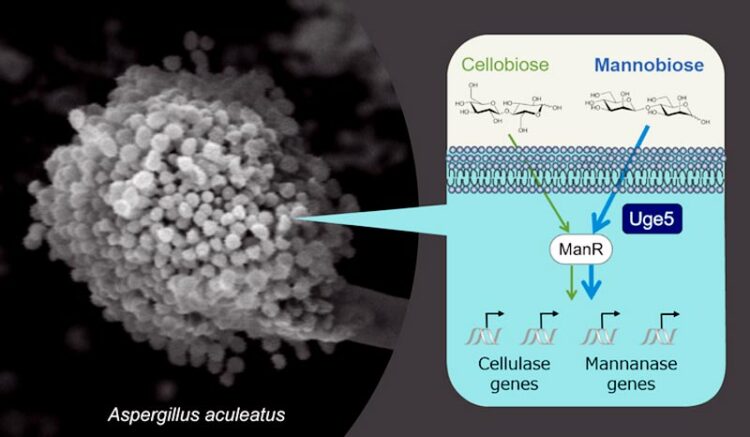Elucidating enzyme gene expression in filamentous fungi

A scanning electron microscopy image of the filamentous fungus A. aculeatus and a gene regulation model in A. aculeatus
Credit: Shuji Tani, Osaka Metropolitan University
… for efficient biomass energy production.
Scientists discover new regulatory mechanisms in molds, potentially enabling a comprehensive high production method for various enzymes that degrade plant biomass.
Filamentous fungi have long been a good friend of sake brewers, but they might soon also be a sidekick for environmentalists. Osaka Metropolitan University researchers have revealed the regulatory mechanisms of enzyme production in a filamentous fungus that allows for efficient degradation of plant biomass, an alternative energy resource to petroleum.
Filamentous fungi (molds) are microorganisms with a long history of use in the fermentation of sake, soy sauce, cheese, and many other products. Such fermentation is a good example of the industrial use of filamentous fungi’s ability to secrete various enzymes in large quantities. Currently, plant biomass is attracting attention as an alternative to petroleum, which will eventually be depleted. Since hard plant cell walls are composed of various aromatics and polysaccharides, their degradation requires a large number of enzymes with diverse characteristics. Consequently, studies have been conducted to utilize filamentous fungi as a prominent source of enzymes for plant biomass degradation.
Delving into this field, a research team led by Associate Professor Shuji Tani, from the Graduate School of Agriculture at Osaka Metropolitan University, analyzed the regulatory mechanisms of carbohydrate-hydrolyzing enzyme production in the filamentous fungus Aspergillus aculeatus, which produces enzymes that have an excellent ability to degrade plant biomass.
Uridine diphosphate (UDP)-glucose 4-epimerase (Uge5) is well known as an enzyme involved in galactose metabolism. However, the team discovered that Uge5 also regulates the expression of degrading enzyme genes in A. aculeatus. This is the very first report of Uge5’s roles in selective gene expression in response to different types of inducing sugars in filamentous fungi.
These findings address the current technology challenge in establishing a much-wanted comprehensive high production method for various enzymes in filamentous fungi.
Professor Tani explained, “We constructed and screened a library containing approximately 9,000 gene-disrupted strains of Aspergillus aculeatus, and identified Uge5 as a novel regulatory factor that regulates the production of carbohydrate-hydrolyzing enzymes. The discovery of this new function took us by surprise. We plan to continue our research to elucidate phenomena that existing knowledge cannot explain.”
The research results were published in Applied Microbiology and Biotechnology on January 10, 2023.
About OMU
Osaka Metropolitan University is a new public university established by a merger between Osaka City University and Osaka Prefecture University in April 2022. For more science news, see https://www.omu.ac.jp/en/, and follow @OsakaMetUniv_en, or search #OMUScience.
Journal: Applied Microbiology and Biotechnology
DOI: 10.1007/s00253-022-12337-8
Method of Research: Experimental study
Subject of Research: Not applicable
Article Title: A new function of a putative UDP-glucose 4-epimerase on the expression of glycoside hydrolase genes in Aspergillus aculeatus
Article Publication Date: 10-Jan-2023
Media Contact
Han Hoang
Osaka Metropolitan University
koho-ipro@ml.omu.ac.jp
@OsakaMetUniv_en
All latest news from the category: Life Sciences and Chemistry
Articles and reports from the Life Sciences and chemistry area deal with applied and basic research into modern biology, chemistry and human medicine.
Valuable information can be found on a range of life sciences fields including bacteriology, biochemistry, bionics, bioinformatics, biophysics, biotechnology, genetics, geobotany, human biology, marine biology, microbiology, molecular biology, cellular biology, zoology, bioinorganic chemistry, microchemistry and environmental chemistry.
Newest articles

First-of-its-kind study uses remote sensing to monitor plastic debris in rivers and lakes
Remote sensing creates a cost-effective solution to monitoring plastic pollution. A first-of-its-kind study from researchers at the University of Minnesota Twin Cities shows how remote sensing can help monitor and…

Laser-based artificial neuron mimics nerve cell functions at lightning speed
With a processing speed a billion times faster than nature, chip-based laser neuron could help advance AI tasks such as pattern recognition and sequence prediction. Researchers have developed a laser-based…

Optimising the processing of plastic waste
Just one look in the yellow bin reveals a colourful jumble of different types of plastic. However, the purer and more uniform plastic waste is, the easier it is to…



